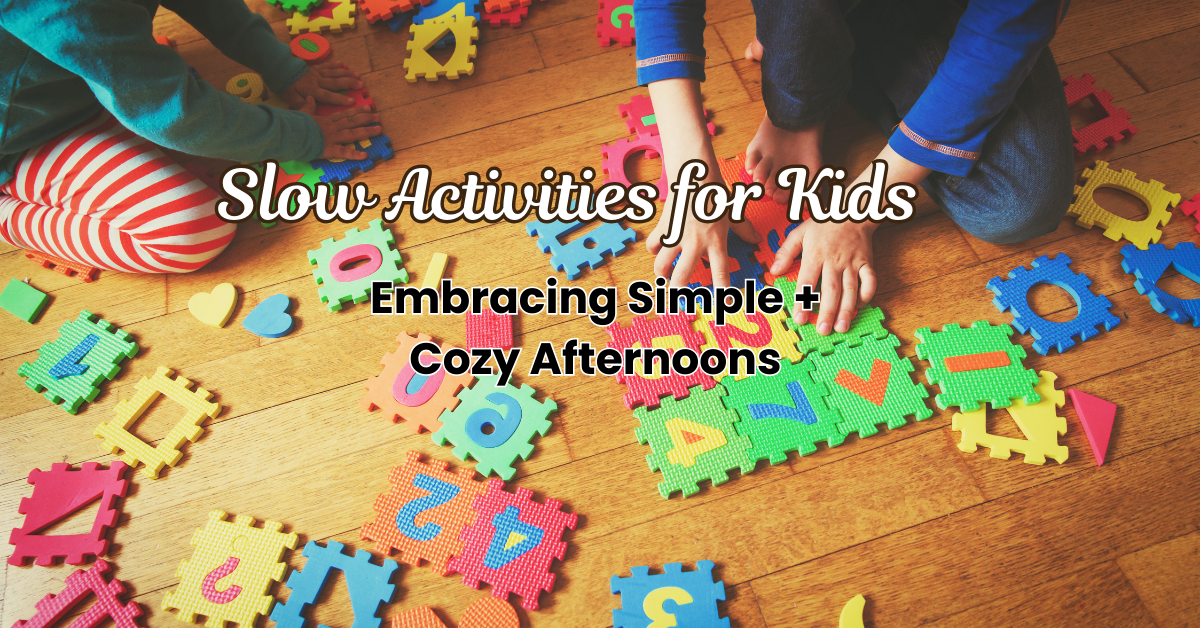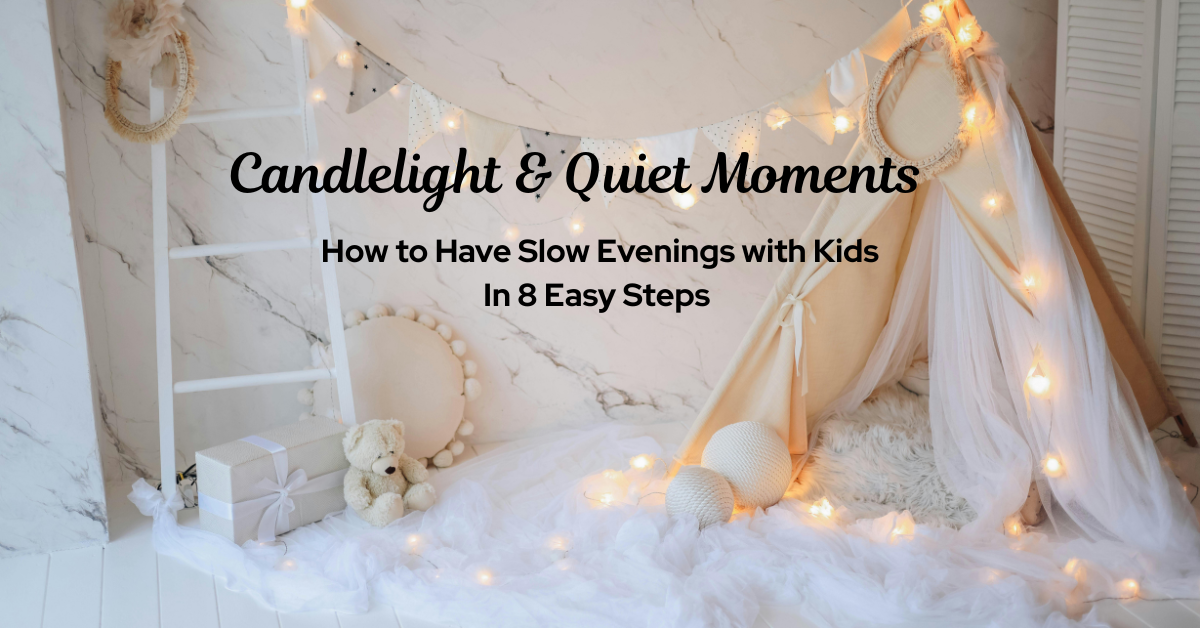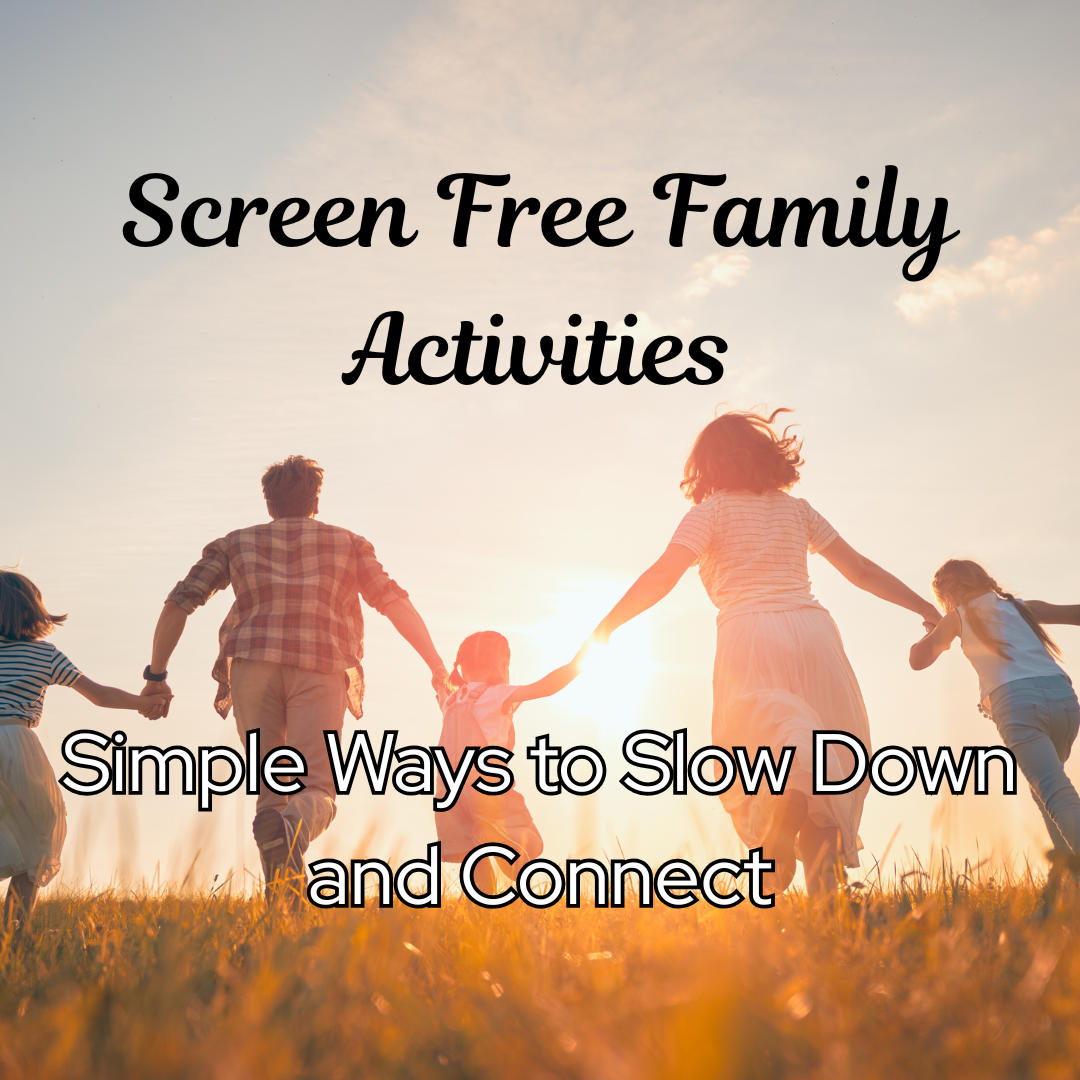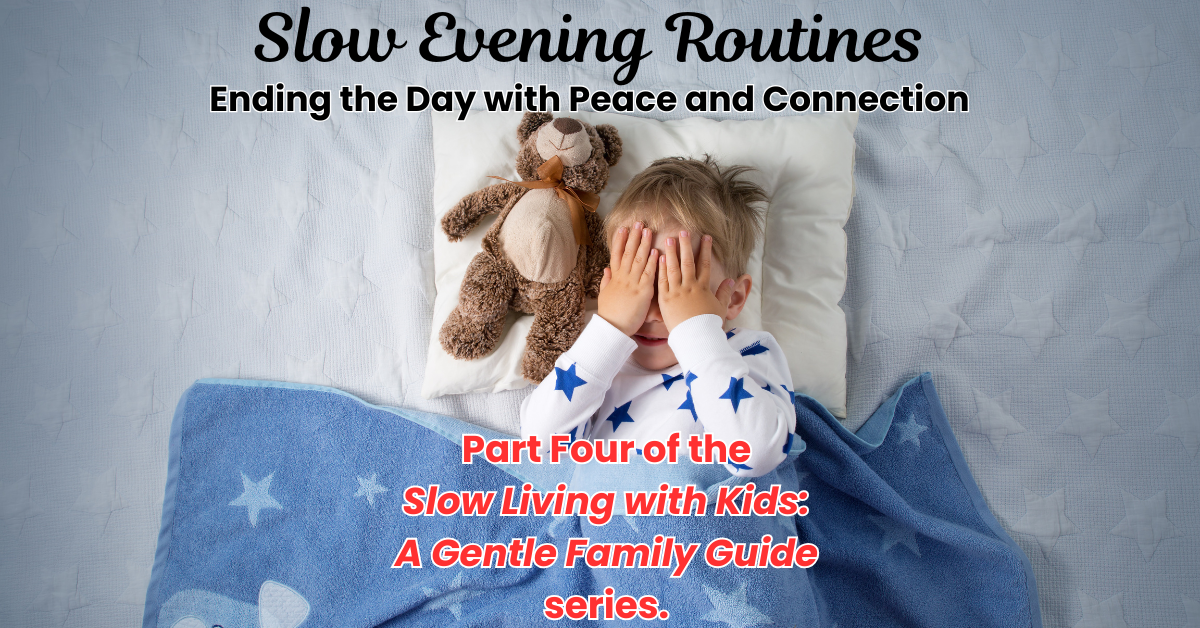Afternoons with kids can feel like the most overwhelming part of the day. School’s out, energy is high (or sometimes crashing), and dinner prep is in the back of your mind. It’s so tempting to hand everyone a screen just to get a few minutes of peace and quiet.
But what if afternoons didn’t have to feel rushed or chaotic? What if, instead of filling every moment with structured activities or doom scrolling, we leaned into a slower pace ? One that gives our kids space to breathe and play while giving us, the parents, a little grace too?
That’s where slow activities for kids comes in.
These activities don’t require expensive supplies, complicated setups, or constant supervision. They’re simple, calming, and often right at your fingertips. Most importantly, they create time for connection, vivid imaginations, and a little rest.
This post may contain affiliate links, which means I may earn a small commission if you choose to make a purchase—at no extra cost to you. I only share products I truly love and believe will add value to your life. Thank you for supporting this cozy corner of the internet!
Why Do Slow Activities Matter?
We live in a world that constantly tells kids (and parents) to do more, go faster, and stay busy. Slowing down your afternoons can offer a counterbalance. Here’s why they matter:
- Kids thrive on unstructured play. It encourages imagination, creativity, problem-solving, and confidence.
- Parents find margin. Not every moment needs to be scheduled. Slow play gives us breathing room too.
- Connection is easier. Quiet, cozy activities invite real conversation and shared presence.
- They help with transitions. Afternoons can be hard after school or naps. Slow activities give a gentle reset before evening routines begin.
Simple Slow Activities for Kids
Here are some of our favorite slow activities for kids that can turn ordinary afternoons into cozy, connection-filled moments.
1. Nature Walks + Backyard Adventures
Even just 20 minutes outside can reset everyone’s mood. If my kids are wild or can’t stop fighting, we go out to the backyard. They can run and scream and get all that out of their little overstimulated bodies. Collect leaves, search for bugs, listen for birds, or simply walk slowly and notice the world together. We live right by a little state park right in the middle of town. There’s a small lake with a boardwalk that goes around it, the perfect spot for nature walks. We also frequent this same spot for fishing when the weather is nice.
For littles: bring a basket or bag for “treasures.”
For older kids: try nature journals when you return home.
2. Invitation to Play
An “invitation to play” is simply setting out a few toys, crafts, or objects in a way that invites exploration. Examples:
- Wooden blocks + toy animals
- Playdough + cookie cutters
- Watercolors + thick paper
- A basket of cozy books + pillows
The setup doesn’t need to be elaborate—just intentional, and something your kids can figure out on their own.
3. Screen-Free Quiet Time
Afternoons are the perfect chance for a little independent downtime. Even if your kids don’t nap anymore, try creating a daily “quiet time” with books, puzzles, or soft music. We generally have our quiet time after dinner since the kids are in school in the afternoons. This also encourages winding down for bedtime. One of our favorite things to do is color together. On weekend afternoons we encourage our kiddos to head into their play room for some independent play. Its not always quiet, but their imaginations are running rampant and the games they come up with amaze me.
Tip: use a timer so kids know when it’s over—this gives them structure while giving you a breather.
4. Baking Together
Afternoons are a wonderful time for baking projects. Don’t try this if you have zero patience. Baking with kids is an adventure, to say the least. I had to quickly become okay with having flour everywhere but the bowl. Easy things like muffins, bread, or even homemade granola are good ideas. Kids can stir, pour, or measure, and the payoff is a cozy snack for everyone.
5. Gardening or Plant Care
I currently have 19 houseplants. My kids love helping outside in the garden or taking care of our houseplants. Watering, digging, or harvesting gives them a connection to the earth and a sense of responsibility. We got this terrarium kit for our daughter to grow her own little plants. She got to paint the unicorns and castle and then plant and take care of the little wheatgrass plants. Every day she would check it and water them. My son has this little one that he takes care of. Having these little things might not seem like a big deal to us adults, but my kids were so proud when their plants started growing. Now they help out in the garden and help with the houseplants too.
6. Cozy Reading Nook
Create a cozy corner with blankets, pillows, and a stack of books. Reading aloud or side-by-side creates some of the sweetest slow activities for kids and parents alike.
7. Art + Creativity Time
Art time is one of the best ways to get my kids to sit and actually focus on something for more than 5 minutes. We have a simple art bin with crayons, scissors, glue, and paper. We keep their painting supplies out of their reach because I don’t quite trust them to set that up on their own yet. Arts and crafts is a great way for kids to get creative and have independent play.
8. Simple Family Games
Games don’t need to be long or competitive. Try puzzles, matching cards, or board games. These encourage teamwork and laughter instead of rivalry. The favorites in our house are Hi Ho Cherry Oh and Bluey Candyland.
9. Gentle Music + Movement
Sometimes kids just need to move their bodies! Try some music, a dance party, or simple yoga stretches. Movement helps them regulate energy while keeping things lighthearted. If you let your kids watch Youtube, we highly recommend Danny Go! He does lots of dancing and interactive videos that get your kids up and moving.
10. Seasonal Crafts + Rhythms
Bring the seasons into your days. In fall, make leaf rubbings. During winter, cut paper snowflakes. In spring, press flowers inside books. During summer, collect outside “treasures and make nature dioramas. These projects connect kids to the natural flow of the year.
Tips for Parents: Making Slow Afternoons Doable
It’s one thing to have a list of slow activities for kids. It’s another to make them realistic for a busy household. Here are a few ways to keep things simple:
- Rotate activities. You don’t need to do everything at once. A few well-loved options are more than enough.
- Prepare simple stations. A basket of puzzles here, an art bin there. Having things ready cuts down on “I’m bored” moments.
- Lower expectations. Kids won’t sit peacefully for hours. Aim for 20–30 minutes of intentional play at a time.
- Involve them in setup + cleanup. This teaches responsibility and makes the activity feel more special.
- Join in sometimes. While independent play is wonderful, shared play builds memories. Even 10 minutes can shift the whole afternoon.
A Sample Slow Afternoon Flow
Here’s what a gentle, slow-living afternoon might look like:
- 3:00 – Kids come home, light snack and chat about the day
- 3:30 – Nature walk around the neighborhood
- 4:00 – Quiet time (books, puzzles, or soft music)
- 4:30 – Simple art project or free play with toys
- 5:00 – Begin dinner prep, with kids helping stir or set the table
This isn’t a strict schedule, but a flow that brings calm instead of chaos.
Why It’s Worth It
Slow afternoons won’t always look picture-perfect. There will be spills, meltdowns(kids and parents), and messes. But when we choose slow living activities for kids, we’re building something deeper:
- A sense of peace in our home
- Stronger family connection
- Childhood memories rooted in presence, not chaos
It’s these small, quiet moments, like reading on the couch, baking muffins, or walking slowly down the block, that kids carry with them after the day is done.
Final Thoughts
Choosing slow activities for kids doesn’t mean rejecting all modern conveniences or structured activities. It means creating a space for presence, play, and peace in everyday family life.
So next time the afternoon slump hits, pause before turning on the TV. Instead, turn on some music, put out some craft supplies, or head into the backyard. You just might be surprised at how much beauty can be found in slowing down.
Read Slow Morning Routines with Kids for ways to start your day slowly and peacefully.






I love this! It’s so easy to get caught up in busy schedules, but slowing down and enjoying simple, cozy activities with kids can be so rewarding. Your ideas are such a great reminder that quality time doesn’t have to be complicated—just mindful and fun. Thank you for sharing!”
Love these ideas! Such helpful tips, including the sample afternoon plan! We really love that there are so many different kinds of activities too.
These are all such wonderful ideas! These slower activities were some of my favorite times as a kid.
My niece had a Baby Shark soft puzzle that she would play with all the time. It’s great for problem solving!
Oh, how much I love this post. Our world is full of go-go-go, I enjoy the simple, quiet afternoons. Thanks for sharing.